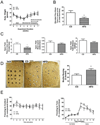Obese-type gut microbiota induce neurobehavioral changes in the absence of obesity
- PMID: 25173628
- PMCID: PMC4297748
- DOI: 10.1016/j.biopsych.2014.07.012
Obese-type gut microbiota induce neurobehavioral changes in the absence of obesity
Abstract
Background: The prevalence of mental illness, particularly depression and dementia, is increased by obesity. Here, we test the hypothesis that obesity-associated changes in gut microbiota are intrinsically able to impair neurocognitive behavior in mice.
Methods: Conventionally housed, nonobese, adult male C57BL/6 mice maintained on a normal chow diet were subjected to a microbiome depletion/transplantation paradigm using microbiota isolated from donors on either a high-fat diet (HFD) or control diet. Following re-colonization, mice were subjected to comprehensive behavioral and biochemical analyses.
Results: The mice given HFD microbiota had significant and selective disruptions in exploratory, cognitive, and stereotypical behavior compared with mice with control diet microbiota in the absence of significant differences in body weight. Sequencing-based phylogenetic analysis confirmed the presence of distinct core microbiota between groups, with alterations in α- and β-diversity, modulation in taxonomic distribution, and statistically significant alterations to metabolically active taxa. HFD microbiota also disrupted markers of intestinal barrier function, increased circulating endotoxin, and increased lymphocyte expression of ionized calcium-binding adapter molecule 1, toll-like receptor 2, and toll-like receptor 4. Finally, evaluation of brain homogenates revealed that HFD-shaped microbiota increased neuroinflammation and disrupted cerebrovascular homeostasis.
Conclusions: Collectively, these data reinforce the link between gut dysbiosis and neurologic dysfunction and suggest that dietary and/or pharmacologic manipulation of gut microbiota could attenuate the neurologic complications of obesity.
Keywords: Gut dysbiosis; Intestinal permeability; Mental health; Neurobehavior; Neuroinflammation; Obesity; Psychiatric disease.
Copyright © 2015 Society of Biological Psychiatry. Published by Elsevier Inc. All rights reserved.
Figures



Comment in
-
Metagenomics: a new frontier for translational research and personalized therapeutics in psychiatry?Biol Psychiatry. 2015 Apr 1;77(7):600-1. doi: 10.1016/j.biopsych.2015.01.013. Biol Psychiatry. 2015. PMID: 25766684 No abstract available.
-
Reply to: High-Fat Diet-Induced Dysbiosis as a Cause of Neuroinflammation.Biol Psychiatry. 2016 Jul 1;80(1):e5-6. doi: 10.1016/j.biopsych.2015.11.006. Epub 2015 Nov 17. Biol Psychiatry. 2016. PMID: 26774965 No abstract available.
-
High-Fat Diet-Induced Dysbiosis as a Cause of Neuroinflammation.Biol Psychiatry. 2016 Jul 1;80(1):e3-4. doi: 10.1016/j.biopsych.2015.10.027. Epub 2015 Nov 17. Biol Psychiatry. 2016. PMID: 26774967 No abstract available.
References
-
- Shih RA, Belmonte PL, Zandi PP. A review of the evidence from family, twin and adoption studies for a genetic contribution to adult psychiatric disorders. Int. Rev. Psychiatry. 2004;16:260–283. - PubMed
-
- Elias MF, Elias PK, Sullivan LM, Wolf PA, D'Agostino RB. Lower cognitive function in the presence of obesity and hypertension: the Framingham Heart Study. Int. J. Obes. Relat. Metab. Disord. 2003;27:260–268. - PubMed
-
- Waldstein SR, Katzel LI. Interactive relations of central versus total obesity and blood pressure to cognitive function. Int. J. Obes. (Lond.) 2006;30:201–207. - PubMed
Publication types
MeSH terms
Grants and funding
- P60 AA009803/AA/NIAAA NIH HHS/United States
- P20 RR021945/RR/NCRR NIH HHS/United States
- P30 DK072476/DK/NIDDK NIH HHS/United States
- P60-AA009803/AA/NIAAA NIH HHS/United States
- P30-DK072476/DK/NIDDK NIH HHS/United States
- P50 AA009803/AA/NIAAA NIH HHS/United States
- P20-RR021945/RR/NCRR NIH HHS/United States
- P01 HL076100/HL/NHLBI NIH HHS/United States
- R21 MH099944/MH/NIMH NIH HHS/United States
- P50 AT002776/AT/NCCIH NIH HHS/United States
- R01 DK047348/DK/NIDDK NIH HHS/United States
- DK047348/DK/NIDDK NIH HHS/United States
LinkOut - more resources
Full Text Sources
Other Literature Sources
Medical

